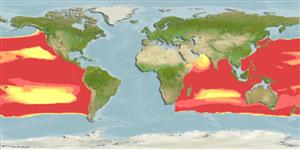>
Anguilliformes (Eels and morays) >
Serrivomeridae (Sawtooth eels)
Etymology: Serrivomer: Latin, serran, serranus, saw + Latin, vomer = ploughshare; in fishes = bone forming the front part of the roof of the mouth (1823) (Ref. 45335); jesperseni: Named after P. Jespersen, monographer of the anguillid letocephalids..
Environment: milieu / climate zone / depth range / distribution range
Écologie
marin bathypélagique; profondeur ? - 825 m (Ref. 6885). Deep-water
Western Pacific: Papua New Guinea. Eastern Pacific: British Columbia, Canada (Ref. 6885), Gulf of Panama (Ref. 6993) and Chile (Ref. 9068).
Taille / Poids / Âge
Maturity: Lm ? range ? - ? cm
Max length : 67.0 cm TL mâle / non sexé; (Ref. 96339)
Description synthétique
Clés d'identification | Morphologie | Morphométrie
Épines dorsales (Total) : 0; Rayons mous dorsaux (Total) : 141 - 170; Épines anales: 0; Rayons mous anaux: 127 - 161; Vertèbres: 150. Dorsal and anal fins confluent with caudal fin; caudal minute and narrow; pectorals small (Ref. 6885). Dark in color; mouth, lining of gill cover, and peritoneum black (Ref. 6885).
Life cycle and mating behavior
Maturities | Reproduction | Spawnings | Egg(s) | Fecundities | Larves
Hart, J.L., 1973. Pacific fishes of Canada. Bull. Fish. Res. Board Can. 180:740 p. (Ref. 6885)
Statut dans la liste rouge de l'IUCN (Ref. 130435)
Menace pour l'homme
Harmless
Utilisations par l'homme
Outils
Articles particuliers
Télécharger en XML
Sources Internet
Estimates based on models
Preferred temperature (Ref.
123201): 7 - 14.8, mean 10.5 °C (based on 453 cells).
Phylogenetic diversity index (Ref.
82804): PD
50 = 0.5059 [Uniqueness, from 0.5 = low to 2.0 = high].
Bayesian length-weight: a=0.00102 (0.00046 - 0.00225), b=3.06 (2.88 - 3.24), in cm total length, based on all LWR estimates for this body shape (Ref.
93245).
Niveau trophique (Ref.
69278): 3.8 ±0.5 se; based on size and trophs of closest relatives
Résilience (Ref.
120179): Faible, temps minimum de doublement de population : 4,5 à 14 années (Assuming tmax>10).
Fishing Vulnerability (Ref.
59153): Moderate to high vulnerability (47 of 100).
